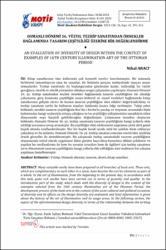Osmanlı Dönemi 16. Yüzyıl Tezhip Sanatından Örnekler Bağlamında Tasarım Çeşitliliği Üzerine Bir Değerlendirme
Künye
ARACI, Nihal. "Osmanlı Dönemi 16. Yüzyıl Tezhip Sanatından Örnekler Bağlamında Tasarım Çeşitliliği Üzerine Bir Değerlendirme". Motif Akademi Halkbilimi Dergisi, 16.41 (2023):391-412.Özet
Kitap sanatlarının tüm dallarında çok kıymetli eserler hazırlanmıştır. Bir anlamda
birbirinin tamamlayıcısı olan bu sanatlar, bir bütünün parçası mahiyetinde taşıyıcı unsur
olmuşlardır. Tezhip sanatında da başlangıcından günümüze kadar, üstlendiği bu vazife
gereğince, nicelik ve nitelik yönünden oldukça zengin çalışmalar yapılmıştır. Osmanlı Dönemi
16. yy. tezhip sanatından seçilen örnekler bağlamında tasarım çeşitliliğinin ele alındığı
çalışmanın giriş kısmında çeşitliliğin sosyo-kültürel ve siyasî vesileleri bağlamında kitap
sanatlarının gelişim süreci ile bunun tasarım çeşitliliğine olan etkileri değerlendirilmiş ve
tezhip sanatının tarihi ile kullanım alanları hakkında kısaca bilgi verilmiştir. Takip eden
bölümde, mezkûr tasarım çeşitliliğinin Kur’ân-ı Kerîm’in yazılışı ve tezyinatı arasındaki ilişki
bakımından hangi veçhesiyle ortaya çıktığına ve bu çeşitliliğin izdüşümünün sanatkârın zihin
dünyasında neye karşılık gelebileceğine değinilmiştir. Çalışmanın temelini oluşturan
bölümde, Osmanlı Dönemi 16. yy. tezhip sanatında tasarım çeşitliliğinin hangi yollarla elde
edildiği sorusuna cevap aranmıştır. Bu çeşitliliğin elde edilmesinin uygulama yönü dört genel
başlık altında sınıflandırılmıştır. Her bir başlık kendi içinde özlü bir şekilde ifade edilmeye
çalışılmış ve bu anlatım, Osmanlı Dönemi 16. yy. tezhip sanatını yansıtan eserlerden seçilmiş
örnek görseller ile desteklenmiştir. Bu çalışmada tezhip sanatındaki tasarım çeşitliliğinin
oluşumunda temel olarak uygulanan fakat gözden kaçırılmış hususlara dikkat çekilmesi ve
yapılan bu sınıflandırma ile hem bu sanatın icracıları hem de ilgilileri için tezhip sanatının
zirve döneminde tasarım çeşitliliğinin hangi yollarla elde edildiğine dair muhtasar bir çalışma
yapılması hedeflenmiştir. Many valuable works have been prepared in all branches of book arts. These arts,
which are complementary to each other in a sense, have become the carrier elements as part of
a whole. In the art of illumination, from the beginning to the present day, in accordance with
this task, quite rich studies have been carried out in terms of quantity and quality. In the
introduction part of the study, which deals with the diversity of design in the context of the
examples selected from the 16th century illumination art of the Ottoman Period, the
development process of the book arts in the context of the socio-cultural and political occasions
of diversity and its effects on the design diversity are evaluated and brief information is given
about the history of the art of illumination and its usage areas. In the following section, the
aspect of the aforementioned design diversity in terms of the relationship between the writing and ornamentation of the Qur'an and what the projection of this diversity can correspond to in
the mental world of the artist is mentioned. In the section that forms the basis of the study, an
answer has been sought to the question of how design diversity was achieved in the 16th century
illumination art of the Ottoman Period. The application aspect of obtaining this diversity is
classified under four general headings. Each title was tried to be expressed concisely in itself and
this expression was supported with sample images selected from the works reflecting the 16th
century illumination art of the Ottoman Period. In this study, it is aimed to draw attention to
the issues that are applied but overlooked as the basis for the formation of design diversity in
the art of illumination and to make a concise study of the ways in which design diversity was
achieved in the peak period of illumination art for both the performers of this art and those
concerned.
Kaynak
Motif Akademi Halkbilimi DergisiCilt
16Sayı
41Bağlantı
https://dergipark.org.tr/tr/pub/mahder/issue/76201/1168735https://hdl.handle.net/11352/4647



















